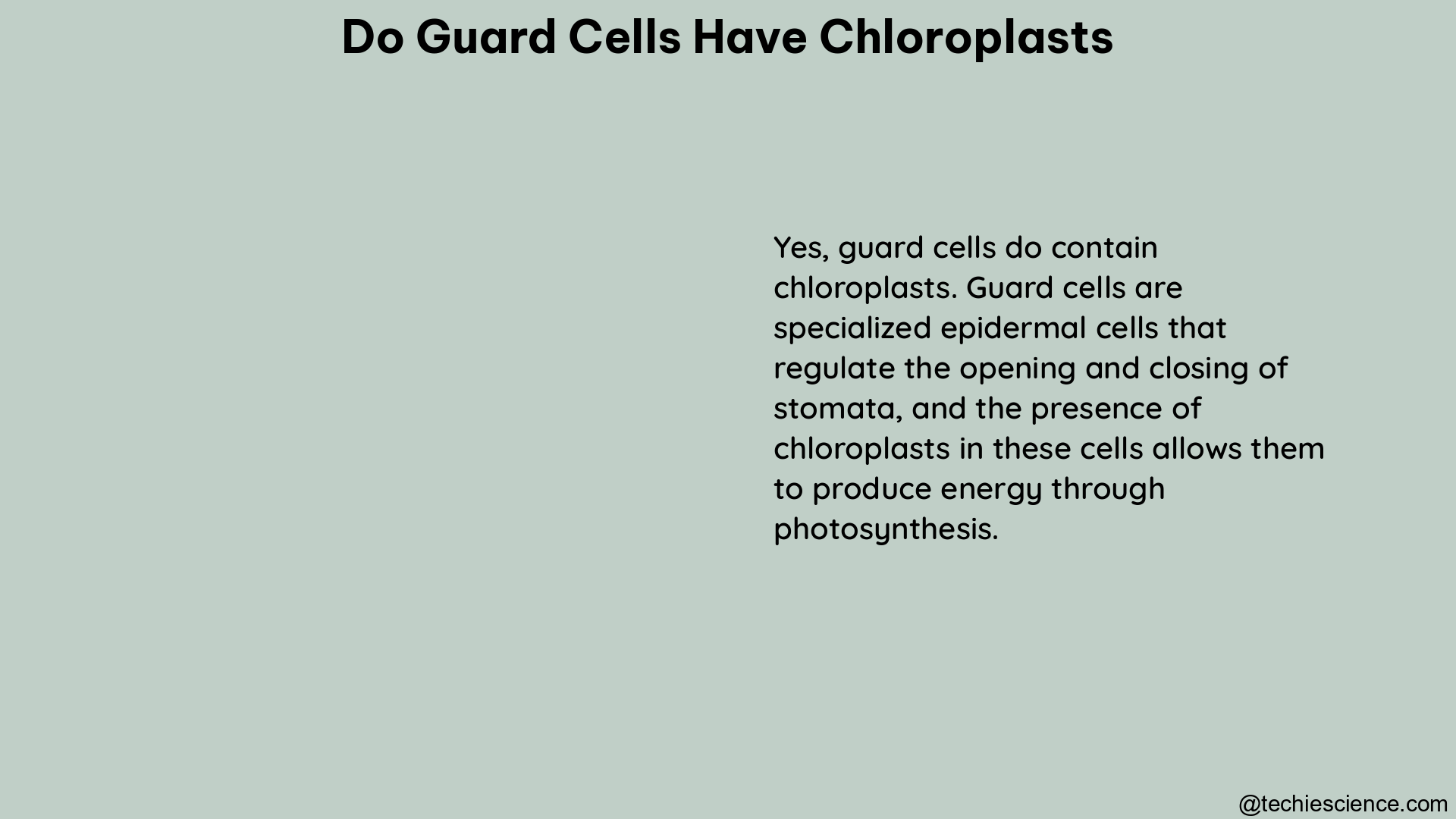Guard cells are specialized epidermal cells found in the leaves of plants that play a crucial role in regulating the opening and closing of stomata, which are the pores responsible for gas exchange between the plant and the atmosphere. The presence of chloroplasts in guard cells is a critical factor in their ability to perform photosynthesis and maintain the necessary turgor pressure for stomatal movement.
Chloroplast Presence in Guard Cells
Yes, guard cells do possess chloroplasts, although the chlorophyll content in these organelles is generally lower compared to the mesophyll cells found in the leaf interior. Studies have shown that:
- More than 90% of guard cells in Arabidopsis plants are chlorophyll-deficient, with chlorophyll auto-fluorescence reduced by up to 84.4% compared to wild-type levels.
- A detailed scatter plot analysis revealed that over 90% of GC-ChlaseΔN guard cells (a transgenic line with reduced chlorophyll levels) had abnormally low chlorophyll levels, and almost all deflated, thin-shaped stomata were chlorophyll-less.
This reduced chlorophyll content in guard cell chloroplasts is believed to be an adaptation that allows for more efficient light absorption and utilization, as guard cells are located on the leaf surface and are exposed to higher light intensities compared to the mesophyll cells.
Photosynthetic Electron Transport in Guard Cell Chloroplasts

The presence of chloroplasts in guard cells enables them to perform photosynthesis, which is crucial for the production of stomatal turgor pressure. However, the photosynthetic efficiency of guard cell chloroplasts differs from that of mesophyll cell chloroplasts:
- The quantum efficiency of photosynthetic electron transport in guard cell chloroplasts is approximately 20% to 30% lower than in mesophyll cells.
- However, the photosynthetic electron transport rate in guard cell chloroplasts is likely to be 70% to 80% of that in chloroplasts of mesophyll cells, provided that light absorption is similar.
This difference in photosynthetic efficiency is due to the unique characteristics of guard cell chloroplasts:
-
CO2 Responsiveness: Photosynthetic electron transport in guard cell chloroplasts responds to the internal, or intercellular, CO2 concentration (Ci) rather than the ambient CO2 concentration (Ca). This allows guard cells to sense and respond to changes in the plant’s internal CO2 levels, which is crucial for regulating stomatal aperture.
-
Calvin Cycle and Rubisco Activity: The Calvin cycle and the enzyme Rubisco (Ribulose-1,5-bisphosphate carboxylase/oxygenase) are active in guard cell chloroplasts, enabling them to fix CO2 and produce the necessary carbohydrates for stomatal turgor production.
-
Photosynthetic Electron Transport Rate: While the quantum efficiency of photosynthetic electron transport in guard cell chloroplasts is lower, the overall photosynthetic electron transport rate is likely to be 70% to 80% of that in mesophyll cell chloroplasts, provided that light absorption is similar.
These unique characteristics of guard cell chloroplasts allow them to respond to the plant’s internal CO2 levels and maintain the necessary turgor pressure for stomatal movement, which is critical for gas exchange and water regulation in the plant.
Importance of Guard Cell Chloroplasts
The presence of chloroplasts in guard cells is essential for their ability to perform photosynthesis and maintain the necessary turgor pressure for stomatal movement. This process is crucial for the plant’s overall gas exchange and water regulation:
-
Stomatal Aperture Regulation: The photosynthetic activity in guard cell chloroplasts, in response to internal CO2 levels, drives the production of carbohydrates and the subsequent changes in guard cell turgor pressure. This, in turn, regulates the opening and closing of stomata, allowing the plant to control water loss and CO2 uptake.
-
Photosynthesis and Carbon Fixation: While the photosynthetic efficiency of guard cell chloroplasts is lower than that of mesophyll cells, their ability to fix CO2 and produce carbohydrates contributes to the overall photosynthetic capacity of the plant.
-
Adaptation to Environmental Conditions: The reduced chlorophyll content in guard cell chloroplasts is an adaptation that allows for more efficient light absorption and utilization, as guard cells are located on the leaf surface and exposed to higher light intensities.
-
Stomatal Responses to Environmental Stimuli: The photosynthetic activity in guard cell chloroplasts, coupled with their ability to sense internal CO2 levels, enables the plant to respond to various environmental cues, such as light, temperature, and humidity, by adjusting stomatal aperture and gas exchange.
In summary, guard cells do possess chloroplasts, although their chlorophyll content is lower than that of mesophyll cells. The presence of chloroplasts in guard cells allows them to perform photosynthesis, which is critical for the production of stomatal turgor pressure and the regulation of gas exchange and water balance in the plant.
References:
- Reckmann, U., Scheibe, R., & Raschke, K. (1990). Rubisco activity in guard cells compared with the solute requirement for stomatal opening. Plant Physiology, 92(1), 246-253. https://www.ncbi.nlm.nih.gov/pmc/articles/PMC1062367/
- Lawson, T., & Blatt, M. R. (2014). Stomatal size, speed, and responsiveness impact on photosynthesis and water use efficiency. Plant Physiology, 164(4), 1556-1570. https://www.ncbi.nlm.nih.gov/pmc/articles/PMC3982707/
- Outlaw, W. H., Jr. (1983). Current concepts on the role of potassium in stomatal movements. Physiologia Plantarum, 59(2), 302-311. https://onlinelibrary.wiley.com/doi/abs/10.1111/j.1399-3054.1983.tb00770.x
- Shimazaki, K. I., Doi, M., Assmann, S. M., & Kinoshita, T. (2007). Light regulation of stomatal movement. Annual Review of Plant Biology, 58, 219-247. https://www.annualreviews.org/doi/abs/10.1146/annurev.arplant.57.032905.105434
- Lawson, T., Oxborough, K., Morison, J. I., & Baker, N. R. (2002). Responses of photosynthetic electron transport in stomatal guard cells and mesophyll cells in intact leaves to light, CO2, and humidity. Plant Physiology, 128(1), 52-62. https://www.ncbi.nlm.nih.gov/pmc/articles/PMC148943/
Hi..I am Moumita Nath, I have completed my Master’s in Biotechnology. I always like to explore new areas in the field of Biotechnology.
Apart from this, I like to read, travel and listen to Music.